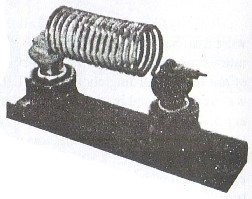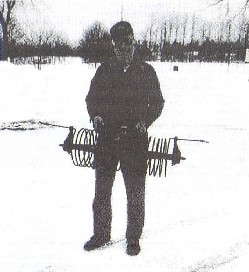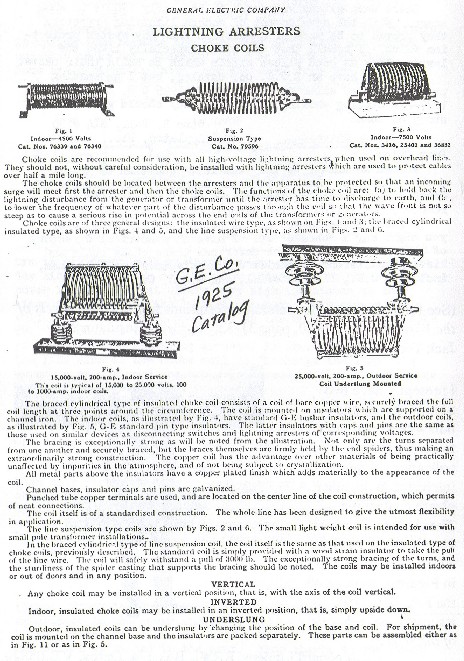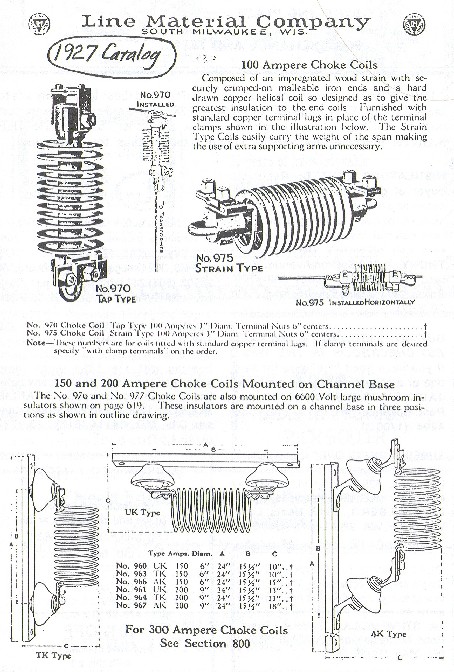Choke Coils
by Leonard (Joe) Lippens
Reprinted from "Crown Jewels of the Wire", June 1999, page 21
It always amazed me that of all the insulator collectors, so few were
associated with the industry. Being a retired lineman, my interest peaked in
1979 when an article appeared in Crown Jewels of the Wire regarding choke coils
(February, 1979). My interest was again aroused by two additional articles in
January and February of 1980.
For a little background history: In October
1945 I became employed by Citizen's Utilities Company (a privately-owned
electric company) as apprentice lineman under the GI bill. At that time there
was a 24,000 volt transmission line between the hydro plant in Newport, Vermont
and West Charleston, Vermont along the Clyde River. There were three of these
choke coils in service at the West Charleston substation. One of the wood
strains in the center of the coil had deteriorated to the point that we
eliminated this choke coil. It was discarded as junk at that time. The second
choke coil was removed after a lightning storm had burned off a conductor about
1970. I have this coil in my possession. The third coil was removed when the
substation was relocated just prior to the article in the 1979 Crown Jewels of
the Wire.
For a little information on the removed coil: The wood strain through
center of the coil was 36" long with an eye on each end for attachment.
There are 20 coils of solid copper, 12" in diameter wrapped around the
strains with solder lugs on each end. I do not know the wire size, but it
measures .412 inch with a micrometer. There is a brass name place attached with
the following information:
CHOKE COIL
Cat. 15973390
Amp 200 Volts 155,000
General Electric
Syracuse, NY
I have no idea why such a high voltage coil was used on 24,000 volt line.
From Crown Jewels of the Wire, October 1979, page 24, "Porcelain
Insulator News" by Jack Tod.
Dear Jack:
The enclosed picture is of an item I found a while back. I thought
it might be of interest to CJ readers who collect the insulator go-with
items .
It was described to me as a "choke coil". The idea was to mount it on
the crossarm and connect it in series with the primary wire so the line current
would flow through the coil (normal current up to the nameplate rating of 50
amps). When the current exceeded the rating (as with lightning), the current
flowing through the coil produced a field which opposed this flow, thereby
"choking" or reducing the transient current peak.

I am not positive
that this was the correct way in which these units were used, but I have never
seen any in service anywhere, so I can't disagree, If you have any more
information (correct use, date of use, value, or whatever), I would be
interested in finding out.
The whole assembly is constructed on a piece of
3" channel iron 17" long. The large coil is 3" outside diameter
and made of AHG #2 copper wire, The husky terminals are cemented into the pin
holes of a pair of ordinary pin type porcelains attached inverted to the base.
Riveted to the side of the channel iron base is a nameplate reading as follows:
ELECTRIC SERVICE SUPPLIES CO.
PHILADELPHIA - NEW YORK - CHICAGO
TYPE LU
No.50457 VOLTS 3000 . AMP 50
Frank Shore
Tucson, Arizona
- - - - - - - - - - -
Dear Frank:
I don't have an answer for what this very interesting
"gismo" is, but maybe one of our elder linemen or electrical engineers
out there can write and tell us. One thing for 'sure is that it must be a real
eye-catcher sitting there with your insulator collection. I can't make a guess as
to "value" of any such oddball items that turn up out of the blue.
Their value depends on the combined thoughts of both seller and buyer -- if a
transaction does take place.
I can't guess its vintage, but E,S.S. Co. was in business from 1906 until at
least the 1930's. Woodward didn't have in his book data on this company, but I
have at least some and will give it below for the benefit of collectors of both
glass and porcelain insulators.

Electric Service Supplies Co, was established in 1906:
President, Charles G. Mayer; V.P. & Treasurer, A. H. Englund -- both
formerly of Mayer & Englund Co. (1901-1906, also of Philadelphia). I
always just assumed this was the same company with merely a corporate name
change.
Knowles cable insulators were jobbed with an embossed M. & E. CO.
marking, and then later with the E. S. S. Co, marking after 1906, The company
probably jobbed porcelain pin types of one or more companies throughout the
years, but a 1928 catalog shows they were then jobbing the complete line of
Franklin Porcelain Co. insulators. Franklin was located in Norristown near
Philadelphia, and there may have been more than a supplier-dealer relationship
between the companies.
E.S,S. Co. used the word "KEYSTONE" as a
trademark (registered #65,586, 10/8/07) and also later a keystone symbolic logo
(registered #80,769, 1/31/11; reregistered #266,285, 1/14/30) . Of very special
interest is the trademark tie-in with the :former Mayer & Englund Co., since
the registration showed "used since" dates from 1906 thru 1926 for
various equipment, plus the conspicuous date of 1901 for "Trolley
Insulators etc." [Was the M & E Co. address also at 17th & Cambria Sts.
in Philadelphia??]
The E.S.S. Co, main office and factory was located at 17th
& Cambria Streets, Philadelphia, Pa. (Don't all you dump diggers get there
the same weekend!). They had sales offices in six other U.S. cities plus three
in Canada,
Other than that, I know nothing more about the company.
Jack
From Crown Jewels of the Wire, January 1980, page 34, "Porcelain
Insulator News" by Jack Tod.
Dear Jack:
In response to your request for help with an answer,
here is some information on Frank Shore's interesting item as pictured on page
24 of the October 1979 issue of CJ.
The device is correctly called a choke coil.
The picture is upside down because the insulator petticoats are turned up; this
choke coil assembly would be mounted underhung. Some are upright as shown,
but the insulators are reversed with their petticoats downward. These are
connected in the circuit as shown in my sketch (copied below).

When lightning strikes an overhead line, a very steep wave front travels
along the line and causes insulation failure in equipment such as transformers
or motors connected to the line. The choke coil has low inductance to the 60
cycle power in the line but offers very high inductance to the steep wave front
of the lightning surge. This causes the voltage crest to be chopped down as the
wave enters the choke coil and reduces the stress on the insulation of the
connected equipment. A lightning arrestor is usually connected on the line side
of the choke coil to discharge the lightning surge to ground, and the choke coil
reduces the surge voltage entering the station bus.
It has probably been 50
years since a choke coil has been installed, and it would be hard to find any in
use today. They were still shown in the 1929 Electric Service Supplies Co.
catalog, and other electrical manufacturers also made these choke coils.
The
reason that their use has been discontinued is that when they were connected to
equipment or a bus with metallic sheath cable, a resonant condition could exist
because of the capacitance of the cable and the inductance of the choke coil.
This would then cause excessively high voltages to build up across the cable and
choke coil, thereby defeating the purpose of the choke coil.
Frank Donnelly
Menlo Parl, Calif.
(Note: Frank is an electrical engineer with considerable experience in the
power industry, and we are fortunate that he keeps feeding us answers on
"whatisits" such as this one and others we've had in the past. Many
thanks to you Frank for this and other answers to our queries.
Jack)
From Crown Jewels of the Wire, February 1980, page 30, "Porcelain Insulator News" by
Jack Tod.
Dear Jack:
Am sending you some data on the "choke coil" as covered by the
letter from Frank Shore in the October 1979 column.
These were extensively used
in the early 1900's in some areas. With the development of modern lightning
arresters they proved to be more of a nuisance than any system
protection value. I recall that the birds especially liked the larger sizes as
good places within which to build their nests.
I do not have an E.S.S. Co.
catalog, but I am sending print copies of selected pages from a 1925 G. E.
catalog and a 1927 L-M catalog showing these, and they should give you the story
on them.
Otto R. Boll, NIA #130
Appleton, Wis.
- - - - - - - - - - -
Dear Otto:
We ran an answer to the "whatisit" question on these
choke coils last month from Frank Donnelly, but a couple of chunks of your
catalog pages might be of interest to our readers (see following two pages).
I
guess I was asleep at the switch on this item -- or you might say I
"choked" up. I have an electrical directory of that same vintage which
describes these choke coils and lists 25 different companies who manufactured or
sold them, including G.E., Line Material, and E.S.S. Co.
Jack
(See following pages for catalog descriptions from Crown Jewels of the
Wire, February 1980, page 31-32, "Porcelain Insulator News" by Jack
Tod.)
|
I presently have two of these heavy and bulky items and intend to keep one
for my collection. Anyone interested in the other, please contact me. The choke
coils which I removed are suspension types as pictured in Figure 2, page 31 of
the February 1980 issue of Crown Jewels of the Wire.
Leonard Lippens, RR #1, Box 374, Derby, VT 05820
|
 |
From Crown Jewels of the Wire, February 1980, page 31,
"Porcelain
Insulator News" by Jack Tod.

From Crown Jewels of the Wire, February 1980, page 32,
"Porcelain
Insulator News" by Jack Tod.

| 